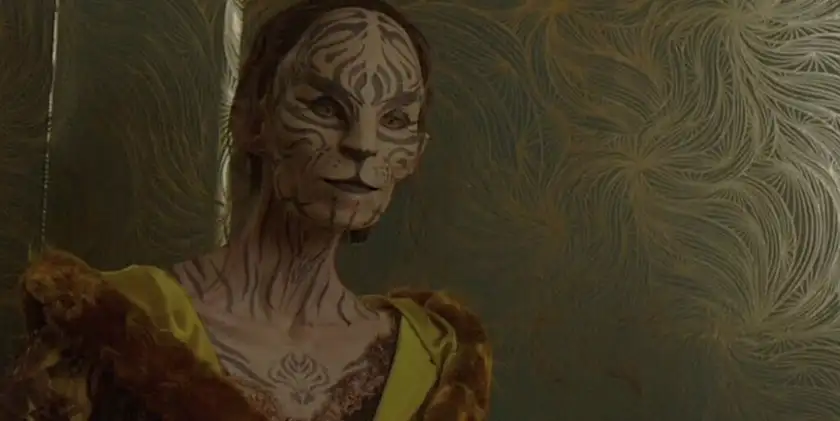Introduction
In the dystopian world of Suzanne Collins’ The Hunger Games series, the characters are often as compelling and complex as the plot itself. One such character is Tigris, a former stylist for the Hunger Games who later becomes an ally to Katniss Everdeen and her team. This article delves into Tigris’s role in the series, her background, and the symbolic significance she holds within the story.
Who is Tigris?
Tigris is introduced in Mockingjay, the third book of the series. She is a former stylist for the Hunger Games, which means she once played a role in preparing tributes for their deadly battles in the arena. By the time Katniss and her team meet her, Tigris has retired and now runs a small shop in the Capitol where she designs and sells clothing.
Tigris is notable for her appearance, which has been heavily altered through numerous surgical modifications to resemble a tiger. Her face is described as cat-like, complete with a flat nose, whiskers, and fur. This transformation reflects the Capitol’s obsession with cosmetic surgery and the lengths to which its citizens will go to achieve their desired looks.
Tigris’s Role in the Rebellion
Tigris plays a crucial role in aiding the rebellion against President Snow and the Capitol. When Katniss, Gale, Peeta, and others are in dire need of a safe place to hide, Tigris provides them with sanctuary in her shop’s basement. Despite her past affiliation with the Capitol, Tigris harbors a deep resentment towards President Snow, which stems from her dismissal as a stylist due to her extreme surgical modifications.
Her willingness to help the rebels illustrates the growing dissent within the Capitol itself and highlights the theme of unity against a common enemy. Tigris’s shop becomes a crucial hideout for Katniss and her team as they plan their final assault on President Snow’s mansion.
Symbolism and Themes
Tigris embodies several key themes in The Hunger Games series, including transformation, identity, and resistance. Her physical transformation into a tiger-like creature symbolizes the extreme measures individuals in the Capitol take to conform to societal standards of beauty and uniqueness. It also serves as a critique of a culture obsessed with appearances and superficial alterations.
Additionally, Tigris’s character arc reflects themes of identity and self-worth. Despite her grotesque modifications, she retains her humanity and compassion, ultimately choosing to support the rebels. This highlights the internal struggle between one’s true self and the persona one adopts to fit into societal expectations.
Tigris and the World of Fashion
Tigris’s background as a stylist provides insight into the Capitol’s fashion industry, which is a prominent aspect of its culture. The elaborate and often bizarre fashion trends in the Capitol are a stark contrast to the utilitarian and subdued clothing of the districts. Tigris’s shop, filled with extravagant costumes and garments, serves as a microcosm of the Capitol’s fashion scene.
Her dismissal as a stylist due to her extreme modifications also underscores the fickle nature of the Capitol’s elite society. It suggests that even those who are part of the system can fall out of favor if they push the boundaries too far, reflecting the Capitol’s underlying hypocrisy and superficiality.
The Impact of Tigris’s Character
While Tigris is a relatively minor character in terms of screen time and book presence, her impact on the narrative and the main characters is significant. She provides a crucial safe haven for the rebels and offers a glimpse into the lives of those living within the Capitol who oppose President Snow’s regime. Tigris’s story also adds depth to the world of The Hunger Games, illustrating that resistance and rebellion come in many forms, and allies can be found in unexpected places.
Read More: The Sanderson Sisters: Witches of Salem
Frequently Asked Questions (FAQ)
Who is Tigris in The Hunger Games?
Tigris is a former stylist for the Hunger Games who has undergone extensive surgical modifications to resemble a tiger. She appears in Mockingjay, the third book of the series, where she aids Katniss Everdeen and the rebel team by providing them a safe hideout in her shop in the Capitol.
Why did Tigris leave her job as a stylist?
Tigris was dismissed from her position as a stylist because her extreme surgical modifications were deemed too grotesque, even by the Capitol’s standards. This highlights the Capitol’s superficial and hypocritical nature.
What does Tigris’s appearance symbolize?
Tigris’s appearance symbolizes the Capitol’s obsession with cosmetic surgery and extreme beauty standards. Her transformation into a tiger-like creature critiques the lengths to which individuals will go to fit into societal norms and the superficiality of the Capitol’s culture.
How does Tigris contribute to the rebellion against President Snow?
Tigris provides sanctuary to Katniss, Gale, Peeta, and their team in her shop’s basement, allowing them to hide and plan their final assault on President Snow. Her support is crucial to the rebels’ efforts and illustrates the internal dissent within the Capitol.
What themes does Tigris’s character explore in the series?
Tigris’s character explores themes of transformation, identity, and resistance. Her physical alterations and subsequent rejection by the Capitol highlight the superficiality and hypocrisy of its society, while her decision to aid the rebels underscores the theme of resistance against tyranny.
How does Tigris’s story add to the world-building of The Hunger Games?
Tigris’s story provides insight into the Capitol’s fashion industry and the lives of those within the Capitol who oppose President Snow. Her character adds depth to the narrative by illustrating that resistance can come from unexpected places and that even those who were once part of the system can turn against it.
Is Tigris related to any other characters in The Hunger Games series?
While the books do not explicitly mention any direct familial relationships, Tigris is often thought to have connections to other characters in the Capitol’s elite, possibly even Snow himself. This connection adds a layer of complexity to her character and her motivations.
Conclusion
Tigris is a fascinating character whose story adds richness to the narrative of The Hunger Games. Her unique appearance, background as a stylist, and role in aiding the rebellion make her a memorable and impactful part of the series. Through Tigris, Suzanne Collins explores themes of transformation, identity, and resistance, providing readers with a deeper understanding of the Capitol’s society and the diverse array of individuals who oppose its tyranny.



